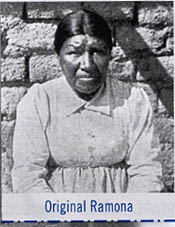
The Column of Lasting Insignificance: December 13, 2008
Although Helen Hunt Jackson’s book was fiction, there actually was a real Ramona, whose story was tracked down by historian Phil Brigandi who, until earlier this year, worked for the Orange County Archives. He uncovered the 1853 birth of Ramona Lubo, in the Coahuilla village of Sahatapa in San Timoteo Canyon. In her teens, she married Juan Diego who was later described as a little crazy, loco, and in one of his moods took a horse from a local rancher, who forthwith shot him dead in the doorway of his home.
Meanwhile, Mrs. Jackson had been doing her research. After traveling with Father Anthony Ubach, into the San Diego back country, visiting San Pasqual and Temecula, places where the “robber whites” (as she called them) had recently evicted the inhabitants, Jackson fired off letters to Secretary of the Interior Henry Teller and Commissioner of Indian Affairs Hiram Price, pleading for government action on behalf of the Sobobas and all the other Mission Indians. It resulted in her appointment as a government commissioner to report on the conditions and needs of the Mission Indians.
When she heard of Diego’s death she became outraged after learning that killing Indians without penalty was not unusual. Although there is no record of her making any personal contact with the principals, her novel sprang from the incident. She had been told by the coroner that “no jury in that part of the country would convict a white man of the murder of an Indian, if only Indian testimony as to the facts were to be had.”

After Diego’s murder, her children also having died while still young, Ramona moved back to the Cahuilla Reservation but naturally the tourists came looking for her — although mysteriously they kept calling her late husband Alessandro. She was pleased to note, though, that the visitors often became customers for her excellent woven baskets and would sometimes give her a dollar or two to pose for a picture. She was even hired to attend a couple of California Fairs to tell her story, but sadly died, aged about 70, a year before the first Ramona Pageant was staged. It did not stop imitators filching her name and passing themselves off as the original.
Picture postcards were sold by the tens of thousands depicting Ramona’s school, her wedding site, two different ranches and countless other sites. Baskets, plaques, pincushions, pillows, and every type of souvenir imaginable filled the curio shops. Overnight, wrote Carey McWilliams, California became “passionately Ramona-conscious” hosting “a Ramona promotion of fantastic proportions.” Four additional books by different authors appeared with Ramona in the title.
Next came the movies, the first in 1910 starring Mary Pickford followed by Dolores Del Rio (complete with theme song) in 1928, Loretta Young and Don Ameche in 1936 and — in recent years — a Mexican-made telenova adaptation.
When McWilliams recounted the Ramona legend in his Southern California: Island on the Land, Jackson’s novel had sold more than 600,000 copies and in Los Angeles alone at least 50 businesses had incorporated Ramona into its name.
Rancho Camulos near Piru was an early target of the tourists, followed by Rancho Guajome near Vista, both resembling descriptive details from the book and with the former claiming to be the ‘House of Ramona.’ Then an adobe in San Gabriel, boasting of possessing “the world’s largest grapevine,” called itself Ramona’s Birthplace. San Diego’s Old Town complex already had an adobe and quickly added a new attraction: Ramona’s Marriage Place. Even Los Angeles got into the act when a promoter opened the Ramona Indian Village which was still attracting tourists in the 1960s.

There was even for a while a town named Alessandro in Riverside County and, 20 miles to the south, the little town of Ramona itself, attractive though it is, merely appropriated the name. Near to Ramona and everybody’s favorite, in this region is the historic gold mining town of Julian (pop: 300 ) famous for its romantic B&Bs, Victorian buildings, and delicious apple pies. For such a small place, Julian keeps pretty busy at this time of the year. It stages both a Bluegrass Festival and a Wine Festival in September, a gathering of the Laguna Mountain Men (“tomahawk tosses”) in October, and a Craft Show and Harvest Hoedown on November. The annual Apple Days just ended, during which visitors were invited to check the stores in search of a Golden Apple, the spotting of which earned a reward.
In December the planting takes place of thousands of daffodils which in February and March lure thousands of visitors “to marvel at the first sniff of spring” as the local guide puts it.
In this orchard-filled area are two especially interesting attractions. The first is open to the public only one day each year, Father’s Day, but it is well worth adding to your schedule. It is the Ilan-Lael Foundation, home and workplace of the polymath James Hubbell and his wife Anne, a series of Gaudi-like buildings set amidst lovely scenery and replete with sculptures, paintings and scores of windows and panels of gorgeous stained glass.
Hubbell has led the building of parks in China, Mexico, and Canada as well as California and you can see him and some of his work at the website www.ilanlaelfoundation.org
Four miles south of Julian is a very different venue, the California Wolf Center (call 619/234-WOLF to make a reservation) where this endangered species is studied, bred and oriented before being released back into the wild.
